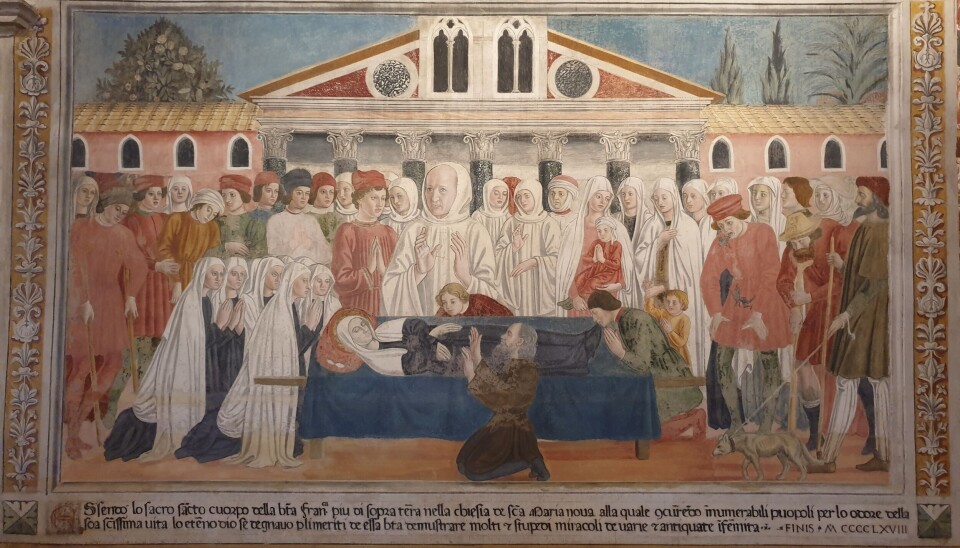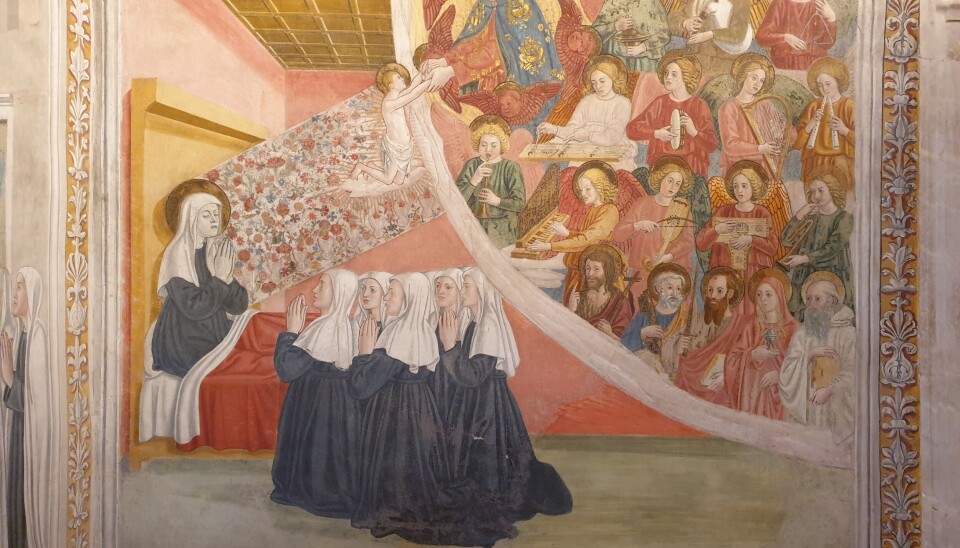
Santa Francesca Romana
A visionary woman at the turn of two councils.
Francesca Bussa dei Ponziani, better known as Santa Francesca Romana, was a visionary woman born in 1384. The political and religious situation was quite troubled at that time. In 1377 the papal court returned to Rome after almost one century of staying in Avignon. However, the year after, in 1378, the pope who moved back to Rome, Gregory XI, died. This provoked an internal conflict among the cardinals. The French wing wanted to return the papal court to Avignon again, while the Italian preferred to stay in Rome. This division led to the election of two different pontiffs, in charge at the same time, who respectively decided to establish their courts in Avignon and in Rome. This was the beginning of the Great Western Schism, which would find an end only with the Council of Constance, in 1417.
Therefore, the historical context in which Francesca Romana was born and lived her first half of her life was characterized by a profound crisis, both of the Church and more in general of the Christianity. Indeed, it was no longer clear which of the pontiffs was the legitimate one. The election of popes by the Avignon court and the Roman one kept continuing, until it was summoned an ecumenical council in Constance, in 1414. Among the personalities that joined this council, one in particular has a specific relevance in this discussion, that is, the French theologian Jean Gerson.
During the council, indeed, he used harsh words towards the category of the visionaries – mostly women. He considered them such a threat for the Church that he wrote down a treatise on discretio spirituum (the ability to distinguish true visionaries from false one), made for confessors to help them in their task. The discretio spirituum is, in short, a way to discern the differences between the vices and virtues, and ought to be a guide for the confessors to decide whether visions were divine or had their origin in the devil’s temptations. In two occasions Gerson referred to visionary women in his treatise. The first one was connected to Birgitta of Sweden’s canonization, in 1391. In this circumstance he not only questioned Birgitta’s holiness, but also the veracity of her visions, assuming that they were not genuine. However, because of Birgitta’s popularity, he had to be careful. It would have brought scandal to the Church and the whole Christianity to describe them as false. Gerson’s second reference to the visionary women is related to their behavior. Supposed visionaries who are too frivolous or want to chit chat (or even touch!) their confessors are not true visionaries, he argued.
Both the critics of Birgitta of Sweden and of the visionary women in general cast shadows on the whole category, with the consequence that visionary women began to be looked at suspiciously. The risk of falling in heresy was right behind the corner. However, Gerson’s treatise and discretio spirituum in general soon became not only a means to condemn the visionaries out of the accepted standards, but also a tool for the visionaries themselves, who could now conform to those same standards.
She began to experience visions starting from 1430, that is, during the last ten years of her life, as she died in 1440. However, the first part of her life is very relevant as well, as it was during this time that she prepared the ground for her own authority, and started to be quite a notorious public figure. According to her hagiographies, she performed several miracles, which helped to increase her fame, such as healings, distribution to the Roman people of food and wine from her family’s warehouse, and so and forth. It is important to stress how Francesca’s experience takes place and finds its development in the city of Rome. Most of the times she is depicted around the city, whether on pilgrimage to the city shrines, or helping the needy. All the care she devoted to Rome and its citizens eventually would have led her to become Advocata Urbis (Advocate of Rome).
During this first period, she was also followed by a spiritual father, who acted in accordance with the discretio spirituum’s dispositions. A group of women began to gather around herself, creating a proper lay community, which would have been officially recognized by pope Eugene IV in 1433. Therefore, until 1430 Francesca Romana was a pia domina (pious woman) and the founder of a female lay community, but not yet a visionary. In 1429 she got a new spiritual father, Giovanni Mattiotti, after the death of the previous one. Mattiotti was Francesca’s confessor until her death in 1440, and also the author of the most important sources on Francesca Romana, namely her hagiography and the collection of visions.
The year 1430 was quite crucial for several reasons. Indeed, at the end of this year the pontiff Martin V summoned a new ecumenical council, in accordance with the decisions taken in Constance. In the same year, Francesca Romana experienced her first vision. This vision expresses all her anxieties for the events which were going to take place. In February 1431, that is, right before the opening of the new council in Basel, Martin V died, forcing the cardinals to quickly elect a new pope, namely Eugene IV. After his election, Eugene showed little interest in the upcoming council, which soon turned out into a proper hostility.

The opposition between the pope and the council corresponded to an opposition between the two strongest religious powers, in fight to determine which was the supreme one. During the Council of Constance both the Avignon pope and the Roman one were deposed in order to elect a new legitimate pontiff, Martin V, who established his court in Rome. To do so, the council’s power had to be raised above the pontiff’s. More than ten years after, in occasion of the Council of Basel, the problem of which power was the strongest one raised again.
In this context, Francesca Romana was afraid of a new upcoming schism. The Roman pontifical power was still unstable. In the first year of his pontificate, Eugene IV did not show any change of mind, indeed, in 1432 his stance towards the council was even worsened. This is probably the reason why Francesca Romana tried personally to intercede with the pope. She experienced a vision in which St. Thomas was entrusting Giovanni Mattiotti, Francesca’s spiritual father, of the task of forwarding her divine message, received in vision, to the pontiff.
The content of this vision is quite important as well. Mattiotti had to admonish Eugene IV to join the Council of Basel. If the pontiff was so unsure on what to do, he could ask his cardinals for help, or other God’s servants, namely Francesca herself. The tone is severe and expresses all the urgency of the matter. The danger was indeed a second schism (“nam imminebat periculum de futuro scismate”, “indeed, the danger of an upcoming schism was close”). However, Eugene IV did not welcome the message and the advice. It is actually written in the source that he did not even care or pay attention to it (“modicum intendit vel ad ipsam ambasciatam modicum attendit”, “he did not care much and paid little attention to the message”). Eventually, joining the council after such a conflict would have meant to accept and agree on the superiority of council’s power, and Eugene could not allow such a submission.
The vision in question represents Francesca Romana’s first appearance on the political scene. All her opera caritatis (charity works) which she did in the first part of her life, all the supposed miracles she performed in the past, and her being a public figure well known in the city of Rome granted her access to the pontiff. It might be said that she did not have much success in forwarding her message, this is true. Still, she was not suspected of heresy. The sources at least never mention this possibility. This is quite important, as the vision is surprisingly critical towards the pontiff. Nonetheless, Eugene IV did not take any measure against Francesca.
In 1432, few months after the above-mentioned vision, Francesca Romana made another attempt. She received a new political vision, basically containing the same message of the previous one. However, this time the rhetorical strategy was far more complex. Francesca, in ecstasy, sees Gregory the Great (540–604). We know that Gregory was an important Roman pontiff, who devoted himself to the spiritual and political guidance of Rome. During his pontificate he had to handle several problems, not last the invasion of Lombards. In other words, Gregory represented a guide for Rome, which apparently Eugene IV was no longer able to be. Moreover, from a rhetorical perspective, it is also clear why the choice to pick another pontiff as interlocutor. It emerges from the text as well, where Gregory approaches Eugene as “colleague and brother”.
Gregory’s speech to Eugene in Francesca’s vision is long, and while some of the previous points are repeated, we can find here new ones as well. Gregory exhorts Eugene IV to save his honor and think of the souls’ sake. It seems indeed that he ignores his actual task as pontiff, that is, to take care of the people’s souls as well as a shepherd takes care of his sheep. He also needs to act quickly, according to Gregory, as there is not much time left, after which Eugene IV will be judged responsible of what he did - or better of what he did not, and of the souls that are going to be lost in sin because of his choices.
However, the pope had more than just one problem to deal with. On one hand, the conflict with the council brought him new enemies. Filippo Maria Visconti became the council’s armed arm, which gave him an excuse to move against the papal territories. On the other hand, Eugene did not either pursuit a wise political strategy in Rome, and this allowed the Colonna family, one of the most important and powerful families in the city, to rise against him. The combination of such threats, both from outside and inside of Rome, led Eugene IV to flee from the city in 1434. He found refuge in Florence, where he would stay for the following ten years.
Rome at this point, thus, was without its political chief once again. However, this also came to represent the peak of Francesca Romana’s political experience. Indeed, in 1434, that is, the very same year as the pope’s refugee, she had a new vision, in which Virgin Mary came to her. The Virgin speaks to the visionary woman, exhorting her to take care of the souls - what Eugene IV was no longer able to do. In this occasion, Francesca Romana is entrusted the job of planning a calendar of masses, processions, and confessions for all the shrines in the city of Rome in favor of all the citizens’ souls. The Virgin Mary, labelled in the vision’s text peccatorum advocata (sinners' advocate), basically asks Francesca to take on her own role, for the sake of the Roman citizens. Francesca Romana becomes here Advocata Urbis. The terrible danger which the city is going to go through may be avoided only thanks to Francesca’s intercession.
This probably represents the highest level in Francesca Romana’s collection of visions. Her authority is not even questioned, and her social and political role is now totally disclosed. It is also important to stress that it happens when the pontiff is far away from the city. Indeed, Francesca is carrying out a task that Eugene IV should have done. While this detail once again highlights Eugene’s incapacity to manage the situation, it also depicts Francesca as a sort of vicar of the pontiff in his role as the religious guide for the city.








